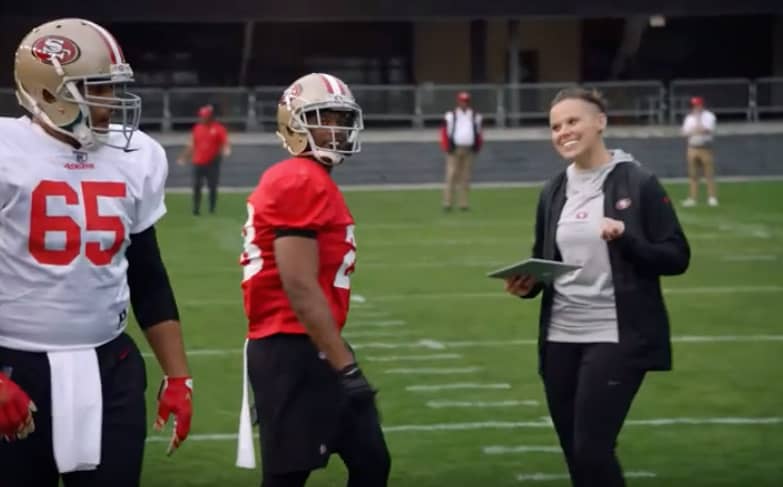
Microsoft’s “Be the One” spot with Katie Sowers.
Source: YouTube
On Sunday evening, millions of people will tune in to the Super Bowl — and roughly half of them will be women. The commercials aired during the most-watched TV program of the year are finally starting to reflect that reality.
NFL Commissioner Roger Goodell said Wednesday the league had reached an all-time high of 187.3 million fans, with 47% made up by women. The ads have long been derided for being at best male-focused and at worst blatantly sexist. Commercials this year from Microsoft, Olay and the NFL itself underscore a new approach.
“We now have the highest fan base ever,” Tim Ellis, NFL’s chief marketing officer, told CNBC in an interview. “That has been driven by an increase in Gen Z and growth of female fans. In fact, our gender balance has reached its highest ever.”
Ellis said female viewership was up 5% for the 2019 season after growing 6% in the year prior. In 2019, 38% of “avid” NFL fans were female, an all-time high, he said.
The league will show a two-minute pre-game ad that, according to Ellis, shows the “passing the torch to the next generation of fans.” It will include 32 kids, about one-third female, representing teams in the NFL and will feature Toni Harris, the first woman to receive a full college scholarship as a position player. In the ad, Harris tackles former NFL linebacker Ray Lewis. Soccer star Carli Lloyd will also be in the ad as a field goal kicker.
Carli Lloyd celebrates scoring the opening goal against Japan in the 2015 Women’s World Cup
Kevin C. Cox | Getty Images Sport | Getty Images
Other Super Bowl ads released in advance include one from Microsoft featuring San Francisco 49ers offensive assistant coach Katie Sowers, who on Sunday will become the first woman to coach in the big game. Olay’s humorous “Make Space for Women” spot makes fun of tropes around “space for women,” and also will raise funds for Girls Who Code. SodaStream’s spot guest-stars Alyssa Carson, an 18-year-old astrobiology student training to be part of the first crewed mission to Mars.
This much is clear: Super Bowl ads are no longer about ogling women in bikinis.
“Now, people know better,” Kathleen Hall, Microsoft’s corporate vice president of brand, advertising and research, told CNBC in an interview about the brand’s in-game spot. “There’s a movement to, ‘at least, let’s not offend people.'”
Hall said Microsoft is aiming higher.
“The bar is not just to be politically correct, but to be proactively supportive of women and their role, and in doing so really anybody,” even beyond gender, she said.
That’s not the case everywhere. New research from Google and the Geena Davis Institute on Gender in Media found male characters receive about 2.5 times more speaking time than female characters in Super Bowl ads and are twice as likely to be portrayed as leaders, based on a study covering ads from 2015 to 2019. Male characters also received 1.5 times the screen time.
‘Toddler steps’
“I guess I would call it toddler steps,” said Charles Taylor, a marketing professor at the Villanova University of Business. Taylor has performed research on the portrayal of women in Super Bowl ads.
From 2008 to 2017, men were featured as “principal characters” in 86% of ads, versus 14% by women, according to his findings.
“It’s a little bit better than baby steps, but the change hasn’t been dramatic,” Taylor said. “And in spite of a fair amount of attention being given to this, we haven’t seen a real quick turnaround.”
Taylor said that when brands feature women characters, the ads tend to perform well and when it comes to blatantly sexual commercials, “the general public has not liked that type of ad in recent Super Bowls.”
Liz Taylor, the global chief creative officer of Publicis Groupe’s Leo Burnett and North American creative lead for Publicis Communications, said that what’s more important than counting the number of male and female appearances is trying to appeal to consumers and representing what the world actually looks like. Leo Burnett and Publicis’ MRY worked with Pop-Tarts in a spot this year, which stars Jonathan Van Ness, known for his role as a grooming expert in Netflix’s “Queer Eye.”
“We’re getting better every year,” she said.
WATCH: Brands tap into Super Bowl mania with experimental marketing



